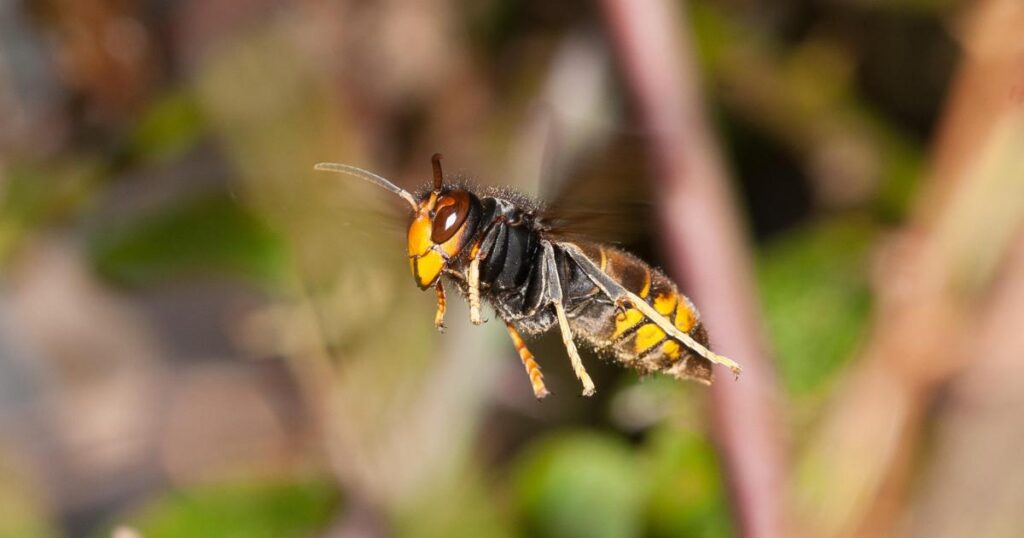So far, 13 sightings of the invasive species have been recorded in 2025.
Formerly known as the Asian hornet, Yellow-legged hornets are a “highly aggressive” predator of native insects and pose a “significant threat” to honeybees and other pollinators in the UK.
Native wild animals in the UK
Confirmed sightings of Yellow-legged (Asian) Hornets in 2025
The confirmed sightings of Yellow-legged (Asian) Hornets in 2025 (at the time of writing), according to the National Bee Unit (NBU) website, are:
- January 23 – Oswestry, Shropshire: Single Yellow-legged Hornet found in imported shallots
- March 17 – Canterbury, Kent: Dead hornet found by member of the public
- April 8 – Marchwood, Hampshire: Yellow-legged Hornet found in a rotary washing line
- April 12 – Deal, Kent: Hornet flew into a conservatory
- April 14 – Applwdore, Kent: Single Yellow-legged Hornet spotted in a greenhouse
- April 14 – Ramsgate, Kent: Another hornet found in a conservatory
- April 16 – Langley, Kent: An embryo nest (later destroyed) and a single hornet were discovered
- April 17 – Hythe, Southampton: A Yellow-legged Hornet was discovered trying to build a nest in a playhouse
- April 19 – Folkestone, Kent: A householder found a Yellow-legged Hornet in their conservatory
- April 23 – Marchwood, Hampshire: A local bee inspector found a Yellow-legged Hornet in a National Bee Unit trap (just 200m away from the sighting on April 8)
- April 28 – Sandwich, Kent: A Yellow-legged Hornet was spotted foraging in a garden
- April 29 – Broad Oak, Kent: Another hornet was captured in a NBU trap
- April 30 – Nonington, Kent: A Yellow-legged Hornet flew into a house
British Pest Control Association supports calls to report Yellow-legged (Asian) Hornet sightings
Experts at the British Pest Control Association (BPCA) have backed calls for Brits to report sightings of the aggressive Yellow-legged Hornets.
BPCA is shining a spotlight on the hornets this week (May 12 to 18) as part of Invasive Species Week, as work continues to prevent them becoming established in the UK.
BPCA technical manager, Nial Gallagher, said: “These invaders are a predator of honeybees and could disrupt our native eco-systems and impact crop production.
“Any sightings should be reported to the Non-Native Species Secretariat and we’d advise getting help from a member of the National Bee Unit or a member of the British Beekeepers Association.
“If you discover a European hornet nest, we always recommend seeking help from a BPCA member, especially if it is indoors, or in a difficult place to access.
“Anyone tempted to try a DIY treatment must be certain any product they choose is licensed for use in the UK and must always strictly adhere to the instructions on the label.”
Some recent media reports have suggested that pest controllers may be able to help with yellow-legged Asian hornets
Currently the only organisation with authority to track & eradicate is the National Bee Unit.
All sightings should be reported using the Asian Hornet Watch app pic.twitter.com/OvSo32QGea— BBKA (@britishbee) May 11, 2025
How to spot and report a Yellow-legged (Asian) Hornet
There are three ways to report a possible sighting of the Yellow-legged (Asian) Hornet:
Mr Gallagher added: “Since 2016 a number of sightings have been recorded in the UK, and anyone who thinks they’ve spotted a Yellow-legged hornet should report it as soon as possible.
RECOMMENDED READING:
“The Yellow-legged hornet is smaller than our native species. It has an orange head, and its entire body is almost entirely dark.
“The abdomen has fine yellow stripes and a yellow or orange segment near the base. Their legs are dark and have yellow tips, where our native hornet has entirely dark legs.
“Yellow-legged hornets may sting, so it’s important not to disturb an active nest and to seek help.”
Have you seen any Yellow-legged (Asian) Hornets this year? Let us know in our poll above or the comments section below.




